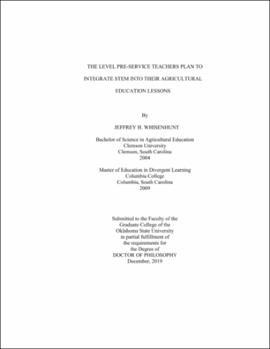| dc.description.abstract | Science, technology, engineering, and mathematics (STEM) education has become increasingly important. Ill-prepared secondary graduates, along with increased demand for qualified STEM employees, sparked a plethora of STEM integration research. This study's purpose was to determine the extent pre-service teachers in agricultural education at Oklahoma State University (OSU) plan to integrate STEM during their 12-week student-teaching internship. Further, this study sought to determine if correlations existed between pre-service teachers' science and mathematics aptitudes, creativity, STEM interest and value, and perceived STEM ability. Pre-service teachers' Oklahoma General Education Test (OGET) science and mathematics scores were used to determine their science and mathematics aptitudes. Mahoney's (2009) Student Attitude Toward STEM (SATSTEM) instrument was used to measure STEM interest and value along with their perceived STEM ability. Aschenbrener's (2008) Creative and Effective Teaching Assessment (CETA) was used to determine self-perceived creativity. Although the study was predominantly descriptive in nature, the final research question employed multiple correlational using Pearson R2. Experienced educators in the respective STEM areas were used to evaluate three randomly selected lesson plans from each participant for their STEM content. Another group of experienced educators evaluated lesson plan quality. The study's findings revealed that pre-service teachers had slightly favorable attitudes, interests, value, and perceived ability regarding STEM. Of the four content areas, science and mathematics were integrated into lesson plans most frequently. Lesson plan quality hindered STEM content identification due to a mean score of 13.22 out of a possible 20. In addition, there was a statistically significant relationship between variables such as science and mathematics aptitudes; STEM value and interest; STEM attitude with interest, value, and perceived ability; and creativity with STEM interest and attitude. It was recommended that the agricultural education teacher preparation unit at Oklahoma State University continue to emphasize the integration of STEM into school-based agricultural education courses. Further, research is needed to fully understand the relationships between pre-service teachers' STEM abilities, attitudes, and creativity. | |
